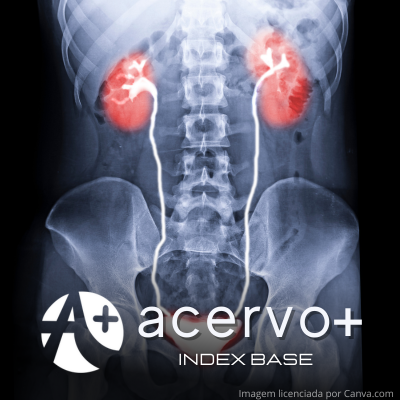Impactos das anomalias anatômicas no trato urinário em crianças
##plugins.themes.bootstrap3.article.main##
Resumo
Objetivo: Analisar as principais anomalias congênitas do rim e trato urinário em crianças, assim como o impacto dessas afecções, suas formas de apresentação e diagnóstico. Revisão bibliográfica: As anomalias congênitas do rim e trato urinário (Congenital Anomalies of the Kidney and the Urinary Tract - CAKUT) são patologias embrionárias de grande incidência em neonatos e podem corroborar para desfechos desfavoráveis na saúde e desenvolvimento da criança. As CAKUT possuem subtipos de classificação e dentre estas patologias destacam-se: Estenose da Junção Ureteropélvica, Refluxo Vesicoureteral, Válvula de uretra posterior e a Doença Renal Crônica. Considerações finais: As anomalias congênitas do rim e trato urinário possuem prevalência no sexo masculino, em nascidos em baixa idade gestacional e possuintes de baixo peso ao nascer. Outrossim, o risco destas anomalias sofre influência direta do histórico de saúde da mãe, evidenciando o impacto de múltiplos fatores para o surgimento dessas afecções. Além do exposto, estudos evidenciam a discrepância em diagnóstico e suporte a essas patologias de acordo com o desenvolvimento do país, fato que reforça a importância do conhecimento acerca do tema a nível nacional no Brasil.
##plugins.themes.bootstrap3.article.details##
Copyright © | Todos os direitos reservados.
A revista detém os direitos autorais exclusivos de publicação deste artigo nos termos da lei 9610/98.
Reprodução parcial
É livre o uso de partes do texto, figuras e questionário do artigo, sendo obrigatória a citação dos autores e revista.
Reprodução total
É expressamente proibida, devendo ser autorizada pela revista.
Referências
2. BĘDZICHOWSKA A, et al. Frequency of infections caused by ESBL - producing bacteria in a pediatric ward - single-center five-year observation. Archives of medical science: MAS, 2019; 15(3): 688-693.
3. CORNWELL LB, et al. Renal Transplants Due to Congenital Anomalies of the Kidney and Urinary Tract (CAKUT) Have Better Graft Survival Than Non-CAKUT Controls: Analysis of Over 10,000 Patients. Urology, 2021; 154: 255-262.
4. ESTEGHAMATI M, et al. Prevalence of reflux nephropathy in Iranian children with solitary kidney: results of a multi-center study. BMC nephrology, 2022; 23: 70.
5. GONG Y, et al. Early detection of congenital anomalies of the kidney and urinary tract: cross-sectional results of a community-based screening and referral study in China. BMJ open, 2018; 8: e020634.
6. GONG Y, et al. Exploration of postnatal integrated management for prenatal renal and urinary tract anomalies in China. The journal of maternal-fetal & neonatal medicine: the official journal of the European Association of Perinatal Medicine, the Federation of Asia and Oceania Perinatal Societies, the International Society of Perinatal Obstetricians, 2021; 34 (3); 360-365.
7. HAMDY RF, et al. Antibiotic Prophylaxis Prescribing Patterns of Pediatric Urologists for Children with Vesicoureteral Reflux and other Congenital Anomalies of the Kidney and Urinary Tract. Urology, 2020; 136: 225-230.
8. HODGES SJ, et al. Posterior urethral valves. The Scientific World Journal, 2009; 9: 1119-1126.
9. JACKSON AR, et al. Roles for urothelium in normal and aberrant urinary tract development. Nature Reviews Urology, 2016; 13 (7): 386-393.
10. JACKSON L, et al. The molecular biology of pelvi-ureteric junction obstruction. Pediatric nephrology, 2018; 33: 553-571.
11. LIN Y, et al. Congenital anterior urethrocutaneous fistula: A systematic review. African journal of paediatric surgery, 2018; 15 (2): 63-68.
12. LOMBEL RM, et al. Urologic Considerations in Pediatric Chronic Kidney Disease. Advances in chronic kidney disease, 2022; 29 (3): 308-317.
13. MCKAY AM, et al. Long-term outcome of kidney transplantation in patients with congenital anomalies of the kidney and urinary tract. Pediatric nephrology, 2019; 34 (11): 2409-2415.
14. NISHIYAMA K, et al. Maternal Chronic Disease and Congenital Anomalies of the Kidney and Urinary Tract in Offspring: A Japanese Cohort Study. Journal of Epidemiology, 2022; 30 (8): 342-349.
15. OKUDA Y, et al. Primary causes of kidney disease and mortality in dialysis-dependent children. Pediatric nephrology, 2020; 35 (5): 851-860.
16. PEREZ JF, et al. Congenital Posterior Urethral Fistulae: Literature Review and Case Report. Urologia internationalis, 2018; 101 (1): 121-124.
17. PERLMAN S, et al. Severe fetal hydronephrosis: the added value of associated congenital anomalies of the kidneys and urinary tract (CAKUT) in the prediction of postnatal outcome. Prenatal diagnosis, 2018; 38 (3): 179-183.
18. RAHMAN AJ, et al. Spectrum, management and outcomes of structural and functional uropathies in children attending a tertiary care center in Karachi; Pakistan. The Journal of the Pakistan Medical Association, 2018; 68 (11): 1699-1704.
19. RODRÍGUEZ MRI, et al. Congenital malformations of the urinary tract: progression to chronic renal disease. Cirugia pediatrica: organo oficial de la Sociedad Espanola de Cirugia Pediatrica, 2022; 35: 172-179.
20. TANGIRALA S, et al. Clinical Profile and Outcome of Children with Congenital Obstructive Uropathy. Indian journal of pediatrics, 2019; 86 (4): 354-359.
21. URISARRI A, et al. Retrospective study to identify risk factors for chronic kidney disease in children with congenital solitary functioning kidney detected by neonatal renal ultrasound screening. Medicine, 2018; 97 (32): e11819.
22. VACHVANICHSANONG P, et al. What Did We Find From Imaging Studies in Childhood Urinary Tract Infection and Which Studies Are Mandatory?. Urology, 2018; 111: 176-182.
23. VAN DER VEN AT, et al. Whole-Exome Sequencing Identifies Causative Mutations in Families with Congenital Anomalies of the Kidney and Urinary Tract. Journal of the American Society of Nephrology, 2018; 29,9: 2348-2361.
24. VISURI S, et al. Prenatal complicated duplex collecting system and ureterocele-Important risk factors for urinary tract infection. Journal of pediatric surgery, 2018; 53 (4): 813-817.
25. WU CW, et al. Risk factors of vesicoureteral reflux and urinary tract infections in children with imperforate anus: A population-based case-control study in Taiwan. Medicine, 2021; 100 (44): e27499.
26. ZHENG Q, et al. Computer aided diagnosis of congenital abnormalities of the kidney and urinary tract in children based on ultrasound imaging data by integrating texture image features and deep transfer learning image features. Journal of pediatric urology, 2019; 15 (1): 75.e1-75.e7.

